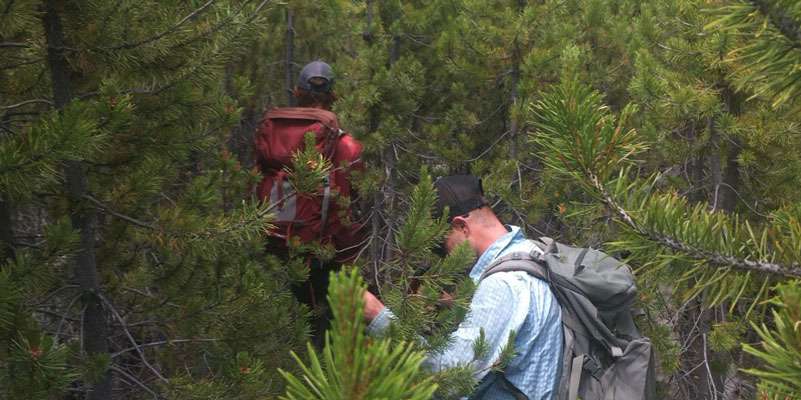
I reached the first clearing in over a mile, and by clearing, I mean I could stretch my arms out without hitting any tree branches. The forest was steep and filled with claustrophobically thick pine and downed trees. I still heard the others bushwhacking, so I waited for them to catch up.
Thirty yards ahead was a GPS point marking where a motionless collar lay. The collar should be attached to a female elk, 1703, who we suspected had died a week earlier, when the collar had stopped moving.
The goal was to find out how she died and recover the three-thousand-dollar collar that told an intimate story of the last two years of her life. This information is vital to understand and conserve elk and other wildlife in Yellowstone.
But getting to the collar wasn’t easy. On the eight-mile trek to 1703, we crossed an icy mountain stream, passed a herd of bison, and watched a grizzly bear walk along the Lamar River, which wasn’t too surprising since this part of Yellowstone has more grizzly bears than almost anywhere in the lower 48.
Standing and waiting for my co-workers in the small clearing, an eerie chill swept over me like the cool October breeze brushing against my skin. My mind wandered to that scene in The Revenant. I shook the image out of my head as they caught up and we pushed on.
The three of us grouped together and headed towards the thick forest patch where the GPS pointed us to, yelling along the way to warn any bears of our presence. We had done this a thousand times before, but for the first time, something yelled back.
Loud grunts, huffs, and crashing branches erupted through the forest from the GPS point, sounds I still hear vividly three years later. Adrenaline and muscle memory kicked in and we all pulled our bear sprays like a wild west quickdraw.
Where would the bear charge from? How close would it get? These thoughts flooded my mind with each careful step backward. After what seemed like an hour, we got far enough away that we no longer felt in danger.
We stopped and reflected on what just happened. “What if I didn’t wait?” “What if we didn’t yell?” But this was short-lived. After all, it was still a long way back to the car, and the sun was getting low.
A year later, we finally retrieved 1703’s collar and found her dead, learning it was a cougar that killed her. But we don’t always get the collar. We don’t always discover how an animal lived or died, and that’s okay.
Fieldwork is dangerous. I can take all the precautions, but sometimes, plans fall apart. And I must decide, are the data worth it? As a scientist, it’s easy to become data-crazed under a “publish or perish'' mentality. I’ve seen people go beyond their limits to get data over a fear of “failure.” I’ve heard horror stories of supervisors pushing field techs to exhaustion to uphold some gold standard of data collection. But more often than not, I can go home, recuperate, and return with a better plan.
Science is a human endeavor. And humans have limits. Acknowledging those limits is the mark of a good scientist as much as the experiments designed or papers published. Whether I’m investigating kill sites in grizzly country or collecting water samples from a lake, I always remember, I’m worth more than the data. —Jack Rabe
